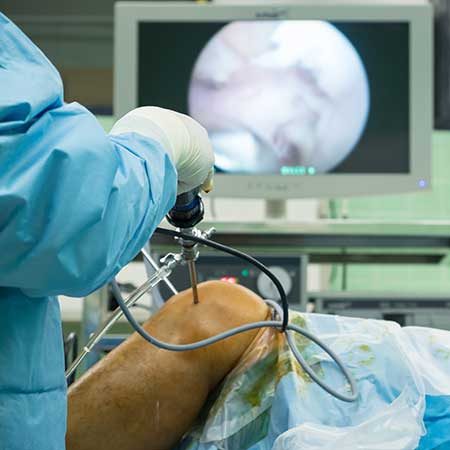Home - Medical Grade Plastics Applications - Implantable PEEK Devices in Arthroscopic Surgery
How can PEEK components aid in arthroscopy procedures?
The arthroscopic procedure dates back more than a century, but like most medical advancements, it took a few decades for the real pioneering work to begin. By the 70s and 80s, most of the tools needed for modern arthroscopic procedures were in place, owing to the invention of flexible fiber optics. Today, arthroscopy is a frontline surgical approach for joint repair, and is particularly commonplace in the knee and shoulder.
Arthroscopy is a favored surgical technique because it is minimally invasive. Whereas older forms of joint repair required surgeons to open up the joint completely, arthroscopic procedures require a pair of small incisions, one for the scope itself and one to thread surgical instruments through. With minimal disruption to the joint, recovery times are greatly reduced, and the likelihood of surgical complications are reduced as well. Less time needed for recovery can be extremely important for athletes, as well as the average patient, who cannot afford much downtime. Further, as the joint does not need to be opened up completely, there is a reduced likelihood of infection.

There are more than four million arthroscopic knee procedures performed every year, and most are for treating ligament or meniscus injuries. Specifically, anterior cruciate ligament (ACL) or posterior cruciate ligament (PCL) reconstruction, the former of which is an extremely common procedure in sports injuries.
Arthroscopy is designed to treat a wide range of shoulder concerns, including rotator cuff tears, chronic tendonitis, subacromial impingement, acromioclavicular osteoarthritis, loose bodies, partial tendon tears and shoulder instability. In short, an exhaustive list of ligament, tendon and inflammatory conditions can be treated with arthroscopy. Shoulder arthroscopy is an important treatment approach, as the reduced recovery time will restore shoulder and arm function sooner.
Arthroscopic procedures are characterized by their minimally invasive nature, and the remote viewing scope that makes the procedure possible. However, some hardware is still necessary in many shoulder and knee arthroscopic procedures. This hardware can include suture anchors, interference screws and pins.
Until recently, titanium and resorbable polymers were the principle materials used in fabricating this hardware, but PEEK components are now a primary choice in arthroscopic fixation hardware. There are several reasons for this, including:
1. PEEK components are biologically inert
Like titanium, PEEK components are tolerated well in the body and are completely biocompatible.
2. PEEK components combine the required strength and the flexibility of polymers
Fixation hardware, like interference screws, must be strong enough to anchor ligaments in place, and do so for a long time. Fixation hardware must also remain flexible enough inside the body to allow full joint range of motion. PEEK components offer both, and therefore provide a perfect balance between titanium’s strength and polymeric flexibility.
3. PEEK components do not interfere with imaging technologies
PEEK does not produce imaging artifacts with CT, MRI or X-ray imaging procedures. The complete radiolucency provides laboratory technicians and surgeons clear images for post-surgical site evaluations. Their transparent nature makes PEEK components a major asset for patient monitoring during the post-surgical healing phase. Should a surgeon prefer to see a PEEK-based implant with imaging procedures, the PEEK polymer can also be modified to offer various levels of radiopacity.
4. PEEK components can be readily revised
Sometimes surgeons need to revise the placement of arthroscopic components like suture anchors during surgeries. PEEK-based components are ideal for this as they can be easily removed by drilling. If needed, PEEK can also be modified with other materials to enhance its strength even further.
As a natural option for soft tissue repair and fixation, PEEK components are a primary choice for arthroscopic procedures, and their role in joint repair will only increase as research into PEEK’s medical applications continues.
